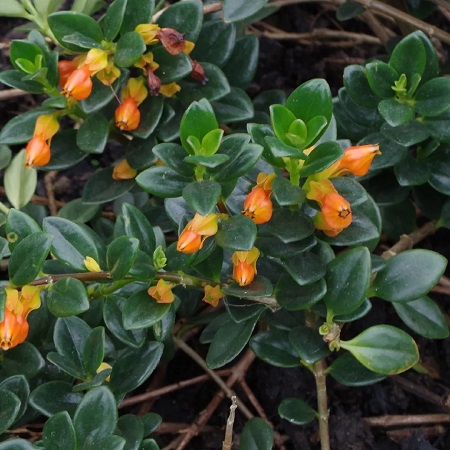The Goldfish Plant (Nematanthus spp.), also known as the Lipstick Plant, is a delightful and eye-catching flowering plant that can bring a burst of color to both your garden and greenhouse. With its vibrant, goldfish-shaped flowers and lush green foliage, it is an attractive addition to any indoor or outdoor space. In this article, we will explore the steps to successfully grow Goldfish Plant in your garden and greenhouse, so you can enjoy its beauty year-round.
Understanding the Goldfish Plant
Goldfish Plants are native to the tropical regions of Central and South America. They thrive in warm, humid environments, making them well-suited for both gardens and greenhouses in moderate to tropical climates.
Garden Planting
Climate and Location

Choose a planting location that receives filtered sunlight or partial shade, especially during the hottest parts of the day. Goldfish Plants prefer temperatures between 65°F to 80°F.
Soil Requirements
Ensure the soil is well-draining and rich in organic matter. A mix of peat moss, compost, and perlite or sand can provide the ideal growing medium for these plants.
Planting
Dig a hole slightly larger than the root ball of the Goldfish Plant. Gently remove the plant from its nursery pot and place it in the hole. Fill the space around the root ball with the prepared soil mix and pat it down gently.
Watering
Keep the soil consistently moist, but avoid overwatering, as soggy soil can lead to root rot. Water the Goldfish Plant whenever the top inch of soil feels dry to the touch.
Mulching
Apply a layer of organic mulch around the base of the plant to retain soil moisture and suppress weeds.
Greenhouse Cultivation
Climate and Environment
Goldfish Plants thrive in a greenhouse with a warm and humid atmosphere. Maintain a temperature range of 65°F to 80°F and provide adequate humidity through misting or using a humidifier.
Potting Mix
Choose a well-draining potting mix that retains moisture without becoming waterlogged. A mix of peat moss, perlite, and vermiculite or orchid bark can be ideal for container cultivation.
Container and Planting
Select a well-draining container with drainage holes and place a layer of small stones at the bottom to aid drainage. Plant the Goldfish Plant in the container at the same depth it was growing in its nursery pot.
Light
Place the container in a spot that receives bright, indirect light. Avoid placing the plant in direct sunlight, as this can scorch its delicate foliage.
Watering and Humidity
Water the Goldfish Plant when the top inch of the potting mix feels dry. Ensure adequate humidity levels in the greenhouse by misting the plant regularly or using a humidity tray.
Fertilization
Feed the Goldfish Plant with a balanced liquid fertilizer diluted to half strength every two to four weeks during the growing season.
Pruning and Maintenance
Regularly remove faded flowers and pinch back the tips of the stems to promote bushier growth and encourage more blooms.
Conclusion
Growing Goldfish Plants can be a rewarding experience, whether in your garden or within the controlled environment of a greenhouse. With the right care and attention to their specific needs, these vibrant plants will reward you with their unique goldfish-shaped flowers and lush green foliage. Whether you choose to cultivate them outdoors or indoors, the Goldfish Plant is sure to add a splash of color and beauty to your surroundings throughout the year.
12 Fun Facts About Goldfish Plant
Common Names
Goldfish plants are also known by various common names, such as Lipstick Plant, Goldfish Vine, and Firecracker Plant. These names reflect the vibrant colors and unique shapes of their flowers.
Goldfish-Shaped Flowers
The most striking feature of the goldfish plant is its flowers, which resemble tiny goldfish with open mouths. The flowers come in shades of orange, red, and yellow, adding a splash of color to any indoor or outdoor space.
Native to the Americas
Goldfish plants are native to the tropical regions of Central and South America, where they grow as epiphytes on trees and rocks. This makes them well-adapted to warm and humid environments.
Epiphytic Growth
In their natural habitat, goldfish plants often grow as epiphytes, meaning they attach themselves to other plants or surfaces but don’t take nutrients from them. They absorb nutrients and water from the air and rain.
Non-Toxic
Goldfish plants are non-toxic to pets and humans, making them a safe and attractive choice for households with curious animals or small children.
Low Maintenance
Goldfish plants are relatively easy to care for, making them suitable for both beginner and experienced plant enthusiasts. They prefer consistent moisture and bright, indirect light.
Attracts Hummingbirds
The colorful and nectar-rich flowers of goldfish plants attract hummingbirds, adding another delightful aspect to these plants.
Long Blooming Period
Goldfish plants can produce flowers throughout the year under optimal conditions. With proper care, they can bloom almost continuously, providing a continuous display of striking colors.
Hanging Basket Favorite
Due to their trailing growth habit and colorful flowers, goldfish plants are commonly grown in hanging baskets. They create stunning displays when allowed to cascade over the edges of the containers.
Propagation
Goldfish plants are easily propagated through stem cuttings. Simply take a cutting with a few nodes, remove the lower leaves, and place it in a well-draining potting mix. With proper care, the cutting will develop roots and grow into a new plant.
Air-Purifying Qualities
Like many houseplants, goldfish plants help improve indoor air quality by removing pollutants and toxins from the air.
Resilient Plants
Goldfish plants are relatively resilient and can tolerate occasional neglect. However, they may become leggy if not provided with sufficient light.
Related Articles & Free Email Newsletter Sign Up
Aloe Plants Offer Medicinal Properties and Ornamental Beauty
Haworthias are Super Succulents for Small Spaces
How to Grow Caladiums for Outdoor Landscapes and Greenhouse Containers




Comment here